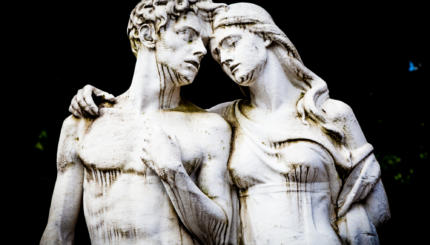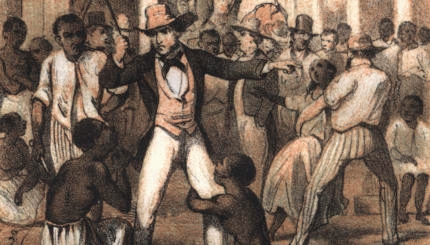For many years, precisely as long as Judaism was marginal to my life, the strict separation of religion and state made perfect sense. The separation principle provided ample camouflage, enabling Jews to stand together against the further Christianization of American public life, yet without asserting anything Jewish. Jews could privatize Judaism, and even trivialize it, while persuading themselves that they were staunch Americans defending the Bill of Rights.
Jews were trapped in a double bind. We claimed allegiance to an American “tradition” of religious tolerance, pluralism, freedom, and separation. But we certainly knew, long before each Dec. 25, that in all but name the United States still was–as Supreme Court Justice Joseph Story had once declared–a “Christian country.” We worshiped at Jefferson’s “wall of separation” without ever learning that the author of that famous phrase had drafted Virginia’s “Bill for Punishing Disturbers of Religious Worship and Sabbath Breakers,” or that the First Amendment was more a monument to federalism and to Protestant definitions of denominational autonomy than to religious freedom.
For Jews, strict separation became a convenient constitutional rationale for strict secularism. Whoever thought to inquire whether the very principle of separation might not be fundamentally Christian? (It was Jesus, not Moses, who distinguished between what must be rendered to God and to Caesar.) In the Jewish historical tradition, religion and nationality were closely intertwined (as for many Israelis they still are).
Nevertheless, we were Americans, and if that required a pledge of allegiance to a principle that undermined our own history and identity as Jews, we would gladly pay the price. Yet Jews were not fools, nor were we fooled. Separation promised protection, in education and politics, against further Christian encroachment. That was sufficient reason for our tenacious defense of it. In the naked public square, we could still pretend that the emperor–or perhaps the rabbi–was fully clothed.

Help us keep Jewish knowledge accessible to millions of people around the world.
Your donation to My Jewish Learning fuels endless journeys of Jewish discovery. With your help, My Jewish Learning can continue to provide nonstop opportunities for learning, connection and growth.
None of this was clear to me at the time. Christmas was only a “national” holiday. Sunday was merely “a day of rest.” Christians deserved to monopolize and control access to positions of public and private power. As Jews, accepting the Christian terms of emancipation, we would behave ourselves by tucking Judaism into our private closets. A double standard, surely, but so much a part of the natural American order that it could hardly be questioned.
Years later, sufficiently provoked by assorted life experiences to examine some cherished assumptions, I prepared a course on religion and the state and, for a book I was writing, read widely in American religious history. The Christian imagery that pervaded American history, from the Puritans to the present, was inescapable. Yet generations of American Jews had been taught that the fondness for “Old Testament” metaphors in American public discourse displayed the fundamental continuity between ancient Jewish and modern American values–when in fact these metaphors expressed a flourishing Christian triumphalism.
Similarly, the First Amendment, that constitutional beacon of religious tolerance, had merely deprived the new federal government of power in the realm of religion, while carefully reserving to the states ample freedom to preserve a Christian commonwealth within their borders, if they were so inclined.
The role of religion in American public life is likely to remain what it has been: pervasively Christian, yet prudently concealed. In a country where 95 percent of the population is nominally Christian, this continues to pose obvious problems for Jews–the more so now that the traditionally united front of Jewish support for strict separation has sharply fragmented.
The enthusiastic advocacy of the Lubavitch for menorahs on public property and public funds for yeshivas has shattered the once monolithic “Jewish” position on church-state issues. With their “establishment” battles securely won, Jews must now decide whether they can tolerate their own religious symbols in the public square, where there are already Christmas trees and creches, or whether it remains too risky to demand the free exercise of Judaism, consistent with the promise of the First Amendment.
The more comfortable I became with Judaism and with Jewish observance the less I could defend the separationist position. Now, it seems a curiously American form of Jewish self-denial whose primary function is to separate religion from life, precisely contrary to Jewish teaching. I can no longer pretend that separation effectively neutralized Christianity. The United States, after all, is a country whose history, calendar, language, and, more than occasionally, law reflect the Christian piety and purpose that framed so much of the American colonial and national experience.
Jews may find it uncomfortable to acknowledge this reality, for it undeniably separates them from the American mainstream. But if Jews do not intend to become even more assimilated than intermarriage, secular liberalism, and assorted other American temptations have already encouraged, their only alternative may be to assert vigorously their own distinctiveness as Jews. If the United States truly is as tolerant of diversity as it claims, then Jews should have nothing to fear from being themselves, in public and in private. If it is not true, then Jews should learn the limits and stop pretending otherwise.
In the end, the role of religion in public life is a prism through which to observe the survival–or atrophy–of American Jewry.
Only after a year in Israel did I have a glimmer of comprehension that there was nothing neutral about any of this.
In the Jewish state, I was astonished to discover, Jews were observant not only at home but also on the street–and rabbis were in the Knesset, as members, not chaplains. The Jewish calendar obliterated American holidays that were also Christian holidays. Menorahs and mezuzahs adorned public buildings. In Jerusalem, especially, the silence of and the solemnity of were strengthened and deepened by the ample support of government authority.
The separation of religion and state might make sense where a tiny Jewish minority needed the benevolence of an overwhelming Christian majority, but, wrenched from the American context, the terms of accommodation to Christian norms were starkly exposed.
This article is excerpted with permission from “American Jews and the Separationist Faith: The New Debate on Religion in Public Life,” edited by David G. Dalin, an online book whose complete text can be found at the website of the Ethics and Public Policy Center.


